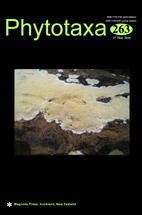Abstract
The stalked diatom Didymosphenia is being thoroughly studied because it can cause serious nuisance blooms. The species most commonly involved is D. geminata. Although Didymosphenia species occur in running waters and lakes, published reports generally refer to lotic habitats. Given the applied interest in Didymosphenia, as well as its suitability for fundamental ecological studies, here we report an observation of a Didymosphenia bloom occurring on the southern part of the eastern shore of the large oligotrophic Lake Hövsgöl (Mongolia). LM and SEM observations revealed that the bloom was formed by Didymosphenia laticollis. The bloom extended for a long stretch of the eastern shore whilst on the opposing lake margin no bloom was visible, where a different Didymosphenia species was collected (D. mongolica). We interpreted the Lake Hövsgöl D. laticollis bloom in light of the most updated knowledge on Didymosphenia blooms ecophysiology. Lake Hövsgöl meets all main environmental requirements for Didymosphenia bloom formation: conditions are oligotrophic and phosphorus is the limiting factor, waters are very transparent and benthic light availability is consequently high, alkalinity is relatively high, and stable rocky substrata in a hydrologically-turbulent environment are widespread. The light-brown color of the bloom is in good agreement with experimental results suggesting that low-SRP conditions promote bloom formation in the presence of high light and alkalinity, because energy is converted to stalk material (the primary site of alkaline phosphatase production in Didymosphenia) rather than in cells. We speculate that the occurrence of the bloom on the eastern shore and its absence on the western shore might depend upon morphology, land use, and climate change causing alkalinity and organic phosphate inputs on the eastern side.

